Table of Contents
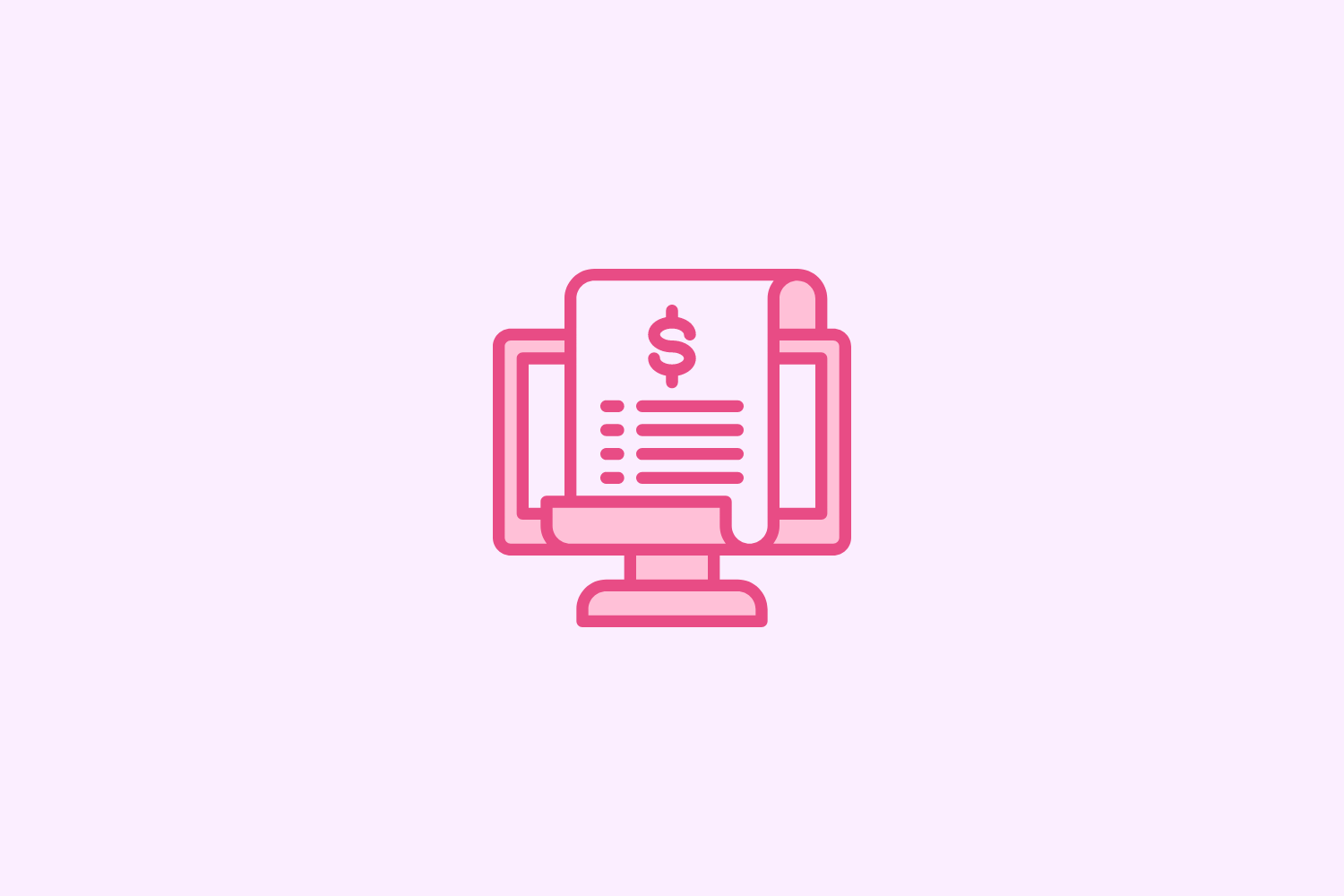
In the early days of running a software company, collecting payments was pretty straightforward.
A customer buys a license for your software, and they get the product (either through a download, a CD or even more old school—floppy disks).
Fast forward to today when most software companies use a SaaS (Software as a Service) business model, and things aren’t as simple.
You have to deal with recurring payments, multiple pricing plans, annual vs monthly payments, add-ons, variable payments and the list goes on.
To put it simply, recurring billing can get complicated, especially for a SaaS company.
Luckily, like most complex processes and tasks, it can be simplified. Let’s dive in!
Three types of SaaS billing systems
Think of the steps a customer goes through in order to subscribe to your SaaS product.
First, they choose a plan and a payment method.
Then, their billing information needs to be collected so you can charge them.
And finally, their subscription needs to be “stored” or saved somewhere so you can charge them monthly and manage things like upgrades, downgrades and discounts.
Each step requires a different system:
- Payment gateway
- Merchant account
- Subscription management
And when you combine them all, it creates a seamless process that’s automated and happens in the background.
Here’s a quick overview of each system, in non-technical jargon:
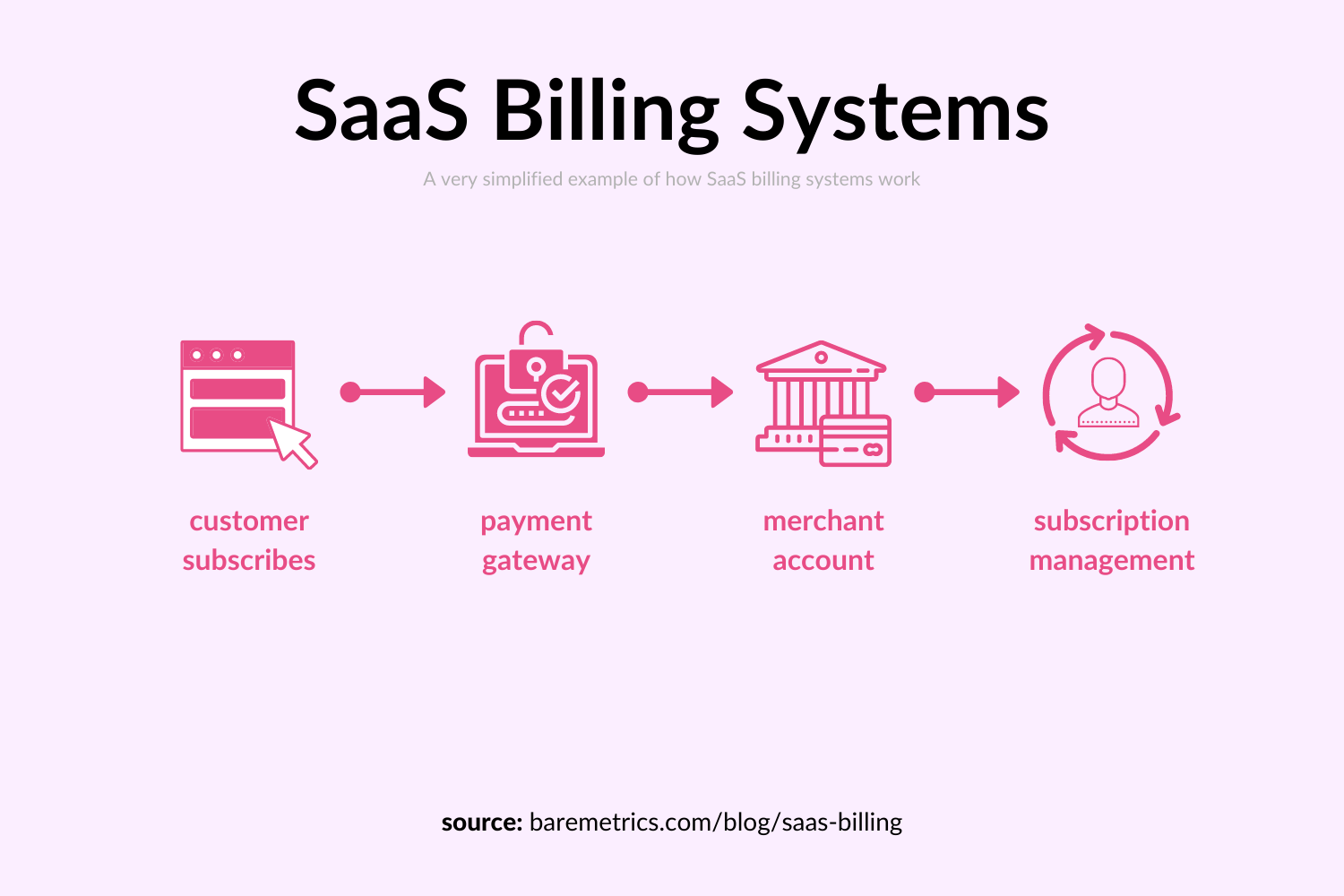
Payment gateway
A payment gateway is a system that allows your customers to send their payment information securely. When your customers enter their credit card and billing information, the payment gateway tells their bank, “This is how much we need to charge.”
PayPal and Stripe are both examples of payment gateways.
Merchant account
A merchant account is an account into which your customer’s payment goes (i.e., how you receive the payment). In other words, your customer says, “Hey, I want to pay you for a subscription,” and your merchant account says, “Cool, you can put that money in here.”
Most of the time, merchant accounts are provided by your payment gateway provider, so it’s pretty hands-off for you. For instance, Stripe and Braintree offer both payment gateways and merchant accounts
Subscription management
A subscription management platform allows you to charge your customer’s billing information on a monthly basis.
Think of it this way. When you make a one-off purchase from an e-commerce company, they only need to charge you once. But when customers sign up for a SaaS subscription, they need to be charged every month, year, or whatever payment cycle they’re on.
The subscription management system allows you to manage that process.
Recurly is an example of a subscription management tool for SaaS.
SaaS analytics (optional, but recommended)
The last part of the system, that’s optional but highly recommended, is a SaaS analytics tool. A SaaS analytics tool works on top of your subscription management system.
Your subscription management system holds and collects a ton of data, but they’re usually not the best at organizing and presenting it to you in a way that you can analyze it. SaaS analytics tools fill that gap.
They allow you to analyze MRR, churn, and other SaaS metrics that are important to your growth.
Here’s the way I like to think about it.
You have a bank or credit card that you use to make payments. Your statement will show you all your transaction information.
But if you want to analyze that data and look for trends so you can budget smarter, make better investments, and improve your overall financial position, you’d use a budgeting tool like Mint or YNAB.
SaaS analytic tools do a similar thing but for your business rather than your personal finances.
Baremetrics is an example of a SaaS analytics tool. You sync up your subscription management platform, and our software organizes everything so you can see your metrics in real time, analyze the data, and make smarter decisions to grow your business.
Best subscription billing services
Ok, so now you know the different parts of SaaS billing. The next step is choosing the right subscription billing service (or services) to collect payments for your SaaS business.
There are a ton of different tools out there, each with their own pros and cons. Some will be a payment gateway but not include a merchant account. Some might be just a subscription management system, but not a payment gateway or merchant account.
It can get confusing.
To help, we’ve reviewed top review sites and analyzed seven of the best SaaS billing services on the market. We’ll discuss what differentiates them, the costs, and some pros and cons of each service.
|
Subscription billing provider comparison |
|||
|---|---|---|---|
|
Billing system |
Payment gateway? |
Merchant Account? |
Price |
| Stripe | Yes | Yes | 2.9% + $0.30 per transaction |
| Braintree | Yes | Yes | 2.9% + $0.30 per transaction |
| Recurly | No | No | $149 per month + 0.9% of revenue |
| Chargebee | No | No | $299 per month for up to $50K monthly revenue * |
| 2Checkout | Yes | Yes | 4.5% + $0.45 per transaction |
| Chargify | No | No | $149 per month for up to $10K monthly revenue |
| Authorize.net | Yes | No | $25 per month, 2.9% + $0.30 per transaction ** |
* also has a free plan for up to $50K in revenue** price includes the payment gateway and merchant account
1. Stripe
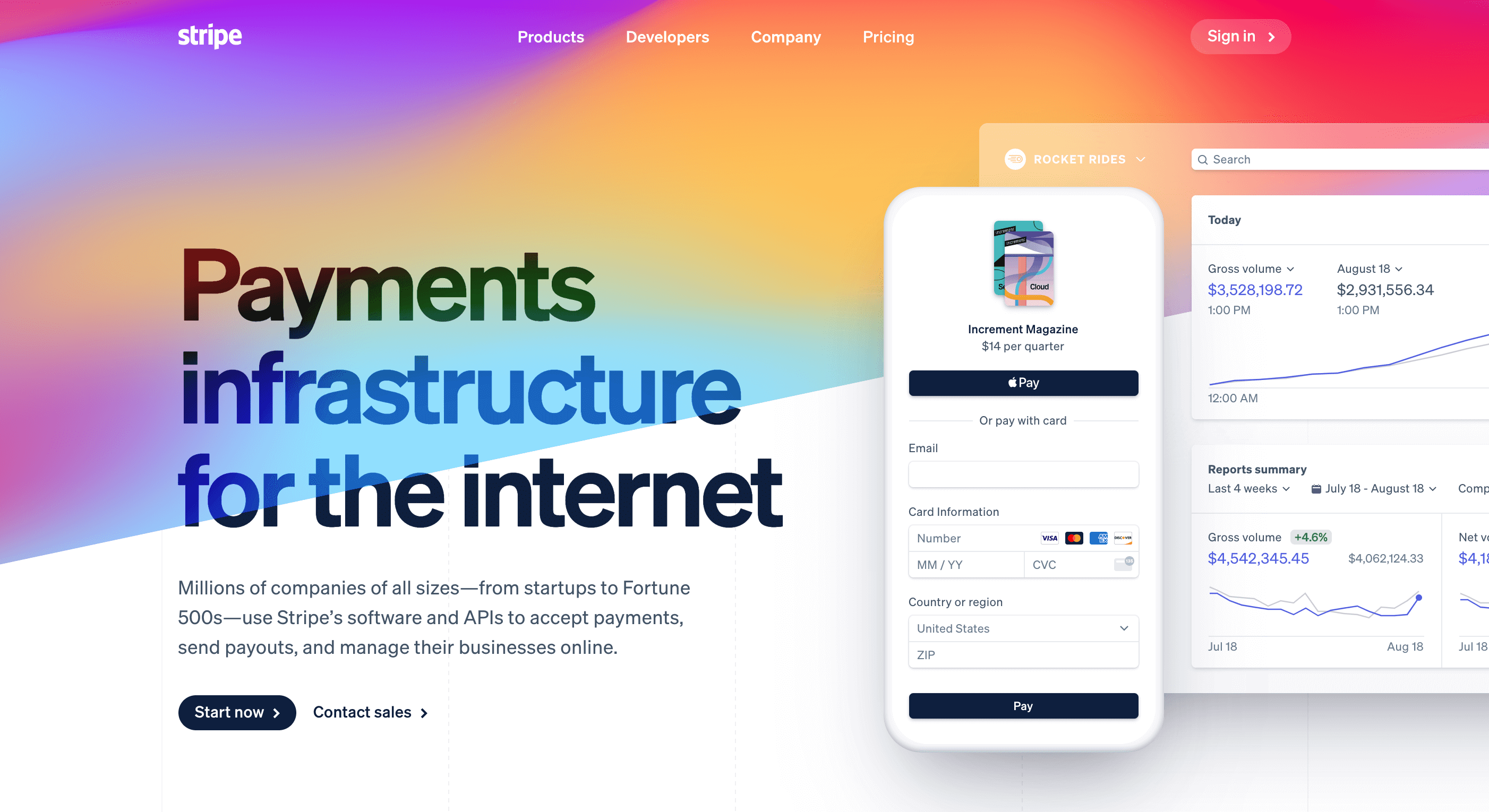
Stripe is probably the most popular SaaS billing system. It works as a payment gateway, merchant account and subscription management platform. Plus, it has some lightweight analytics features.
Part of the reason Stripe billing is so popular is that it’s fairly easy to set up and their usage based pricing makes it easy for any SaaS startup to sign up and start using them.
Stripe pros:
- Tons of integrations
- The pricing model is great for new SaaS companies
- Simplified setup process
- All-in-one solution
Stripe cons:
- As you scale, the fees can add up
- The built-in analytics are limited
- The pricing can start to get a little confusing with their add-on services
Stripe Pricing
Stripe charges a fee of 2.9% + $0.30 per transaction. It charges additional fees for other services, such as instant payout, advanced fraud detection, and more.
Who is Stripe best for?
Stripe is a good fit for most SaaS companies, particularly those just starting out. There’s no monthly fee, it’s easy to set up, and it integrates with tools you’re probably already using to run your business.
2. Braintree
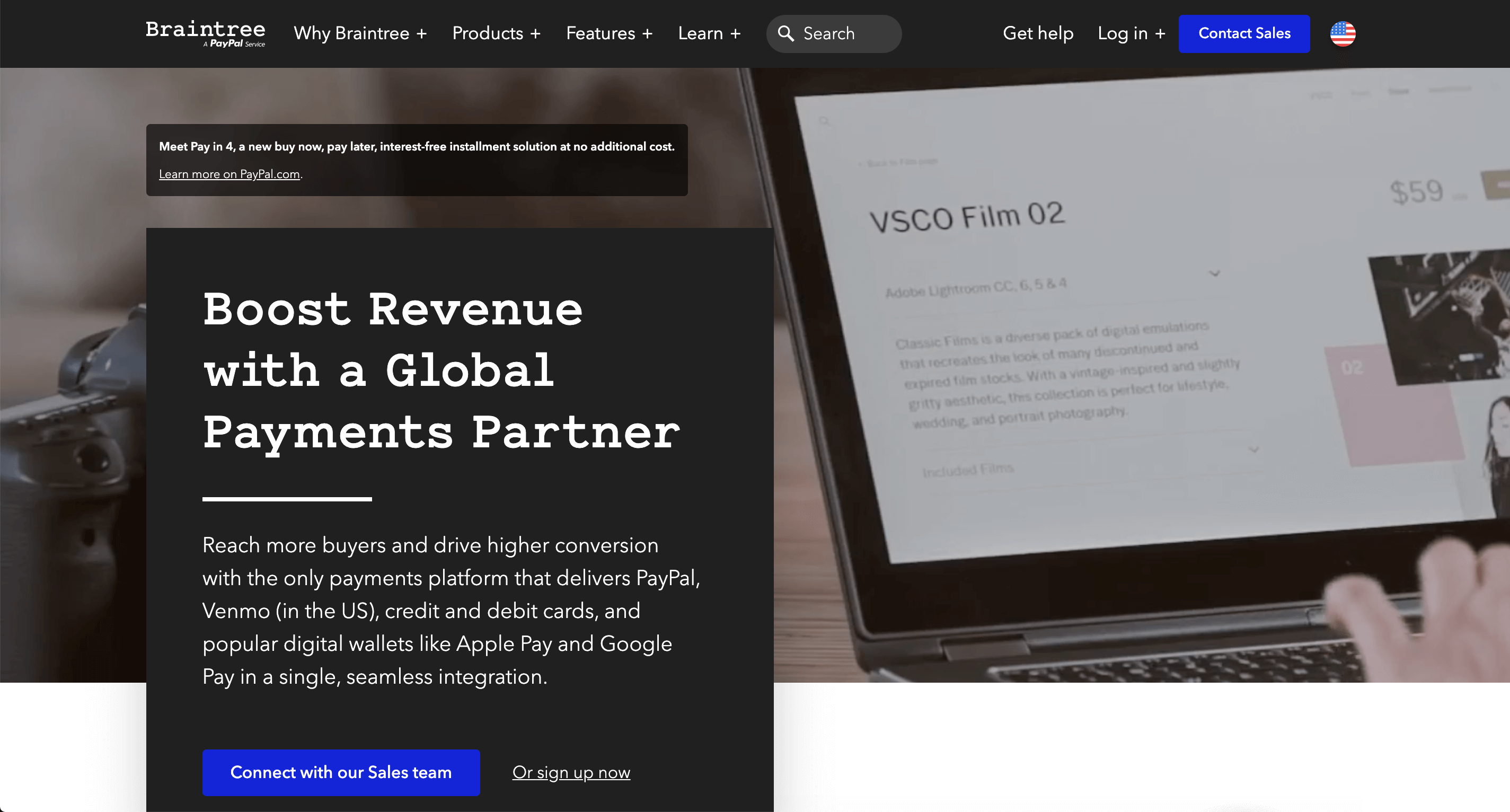
Braintree is owned by PayPal, and has grown to become kind of a Stripe alternative for SaaS companies. Similar to Stripe, Braintree is a payment gateway, merchant account and subscription management platform.
Since it’s a subsidiary of PayPal, you get the added benefit of being able to offer PayPal for payments. Braintree also works well for mobile apps, in addition to traditional SaaS.
Braintree pros:
- Clear pricing
- Available for over 45 countries
- Accept Payal payments
- It can integrate with your existing merchant account
Braintree cons:
- You’ll need a subscription analytics tool for reporting (Iike Baremetrics)
- More tailored towards one-off transactions than for SaaS companies
Braintree pricing
Braintree charges a fee of 2.9% + $0.30 per transaction.
Who is Braintree best for?
Braintree is good for international SaaS companies or SaaS companies that want to accept PayPal payments. Or if you just don’t want to use Stripe for some reason, Braintree is an alternative option.
3. Recurly

Recurly is a subscription management system that gives you more features than you’ll get from all-in-one SaaS billing options like Stripe and Braintree for managing recurring billing.
However, in order to use Recurly, you’ll need a payment gateway and Merchant account. This means you’ll likely use Recurly on top of a service like Stripe or Braintree.
The benefit though, is you’ll get better reporting, full-on subscription management and more flexibility for different billing models. For instance, whether you offer usage-based pricing, tiered pricing, or some type of hybrid, Recurly can be set up to manage billing for any of them.
Recurly pros:
- Tons of integrations (including Baremetrics!)
- Works with most subscription pricing models
Recurly cons:
- The reporting isn’t as advanced as you’d get with a full-on SaaS analytics tool
- Not super customizable
Recurly pricing
Recurly starts at $149 per month, plus 0.9% of revenue.
Who is Recurly best for?
Recurly is an option for subscription businesses with a payment gateway and merchant account but wants more subscription management options.
4. Chargebee
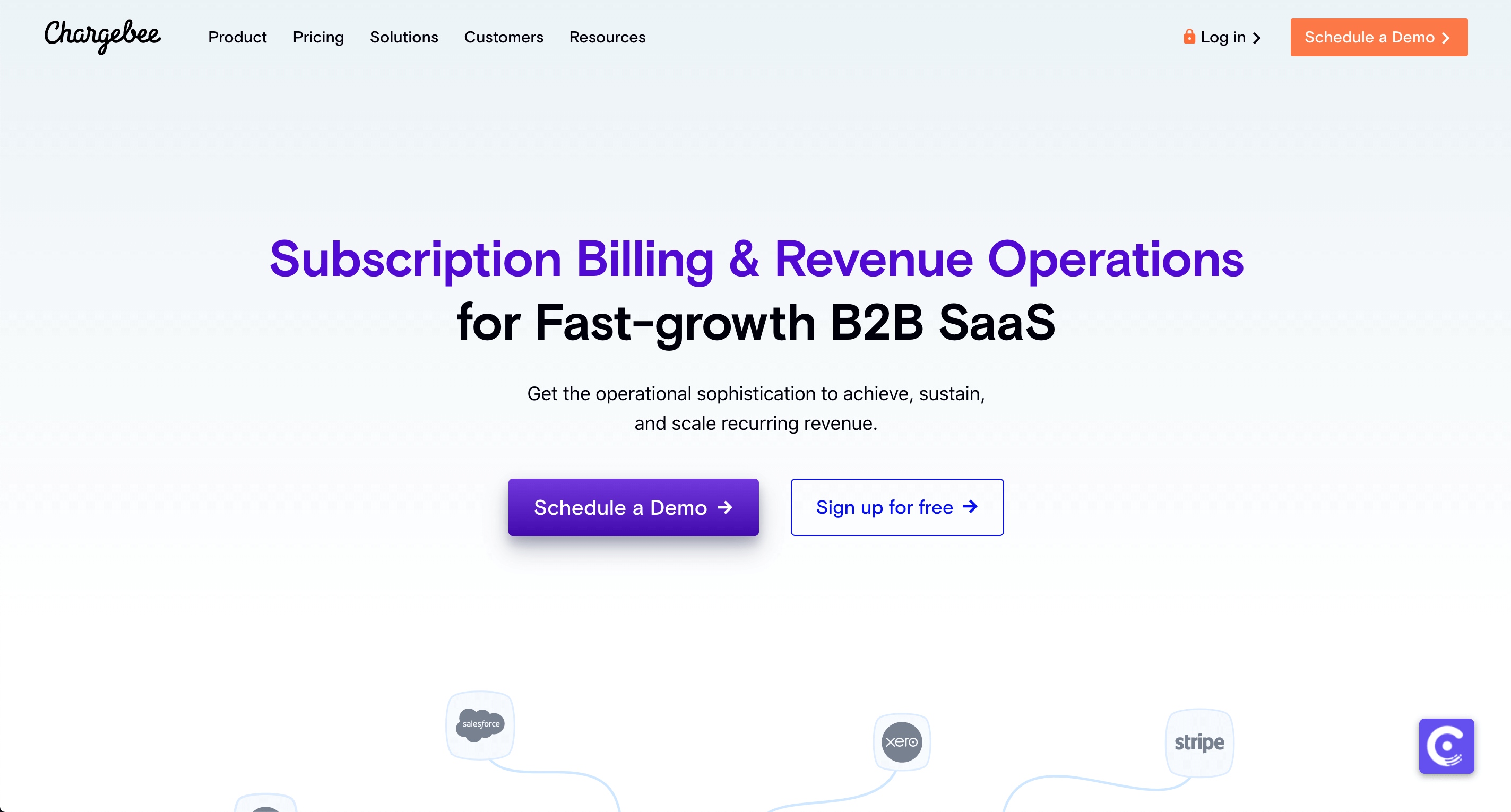
Chargebee is a subscription management system for handling SaaS subscriptions and recurring billing. Similar to Recurly, Chargebee is not a payment gateway or merchant account provider, so you’ll need to use it on top of another service.
One of the biggest upsides of Chargebee however, is they specifically cater to SaaS businesses. They have options for pricing experimentation, upselling, revenue recognition, managing trials and more.
So Chargebee isn’t just collecting and organizing your subscriptions, it makes it easier to test and optimize your SaaS billing strategy as well.
Chargebee pros:
- Tons of options to experiment with pricing and billing
- Out-of-the-box setup or customize with their API
- A lot of flexibility
Chargebee cons:
- Not the prettiest UI
- All the settings and customization options can be overwhelming
Chargebee pricing
Chargebee offers monthly and annual plans, starting at $249/month (for annual plans). The annual plan includes $600K in revenue and 0.6% of any monthly revenue over that.
Chargebee also offers a free plan for MRR under $50K.
Who is Chargebee best for?
Chargebee is a good option for SaaS companies experimenting with different pricing and activation models.
5. 2Checkout
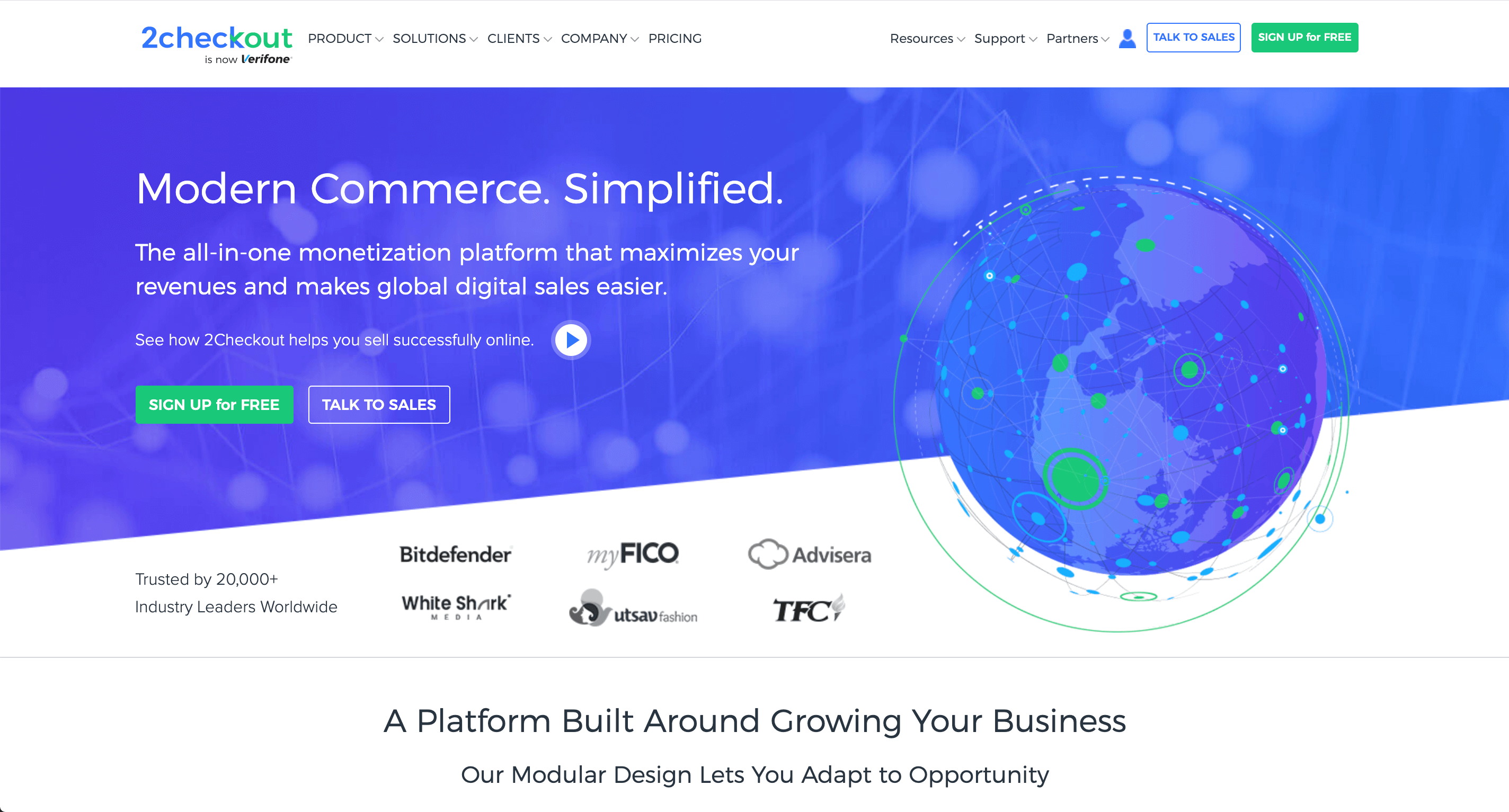
2Checkout (now Verifone) is an online payment processor that handles everything from selling physical products to digital goods and subscription services.
While they offer a line of products, the one for SaaS companies is called 2Subscribe, which is for recurring revenue businesses. It’s a complete SaaS billing solution that covers your payment gateway, merchant account, and subscription management.
They’re geared more towards enterprise SaaS companies than smaller startups (as noted through their website copy), but that comes with its own set of benefits.
For instance, you can accept payments from over 200 countries and you have access to their affiliate network to get more exposure for your SaaS product.
2Checkout pros:
- End-to-end SaaS billing solution
- The affiliate network gives you extra exposure
- Good for global brands
2Checkout cons:
- On the pricier side
- A long setup process
2checkout pricing
The 2Subscribe plan charges 4.5% + $0.45 per transaction.
Who is 2Checkout for?
2Checkout is a good option for larger SaaS companies that want a more enterprise SaaS billing solution.
6. Chargify
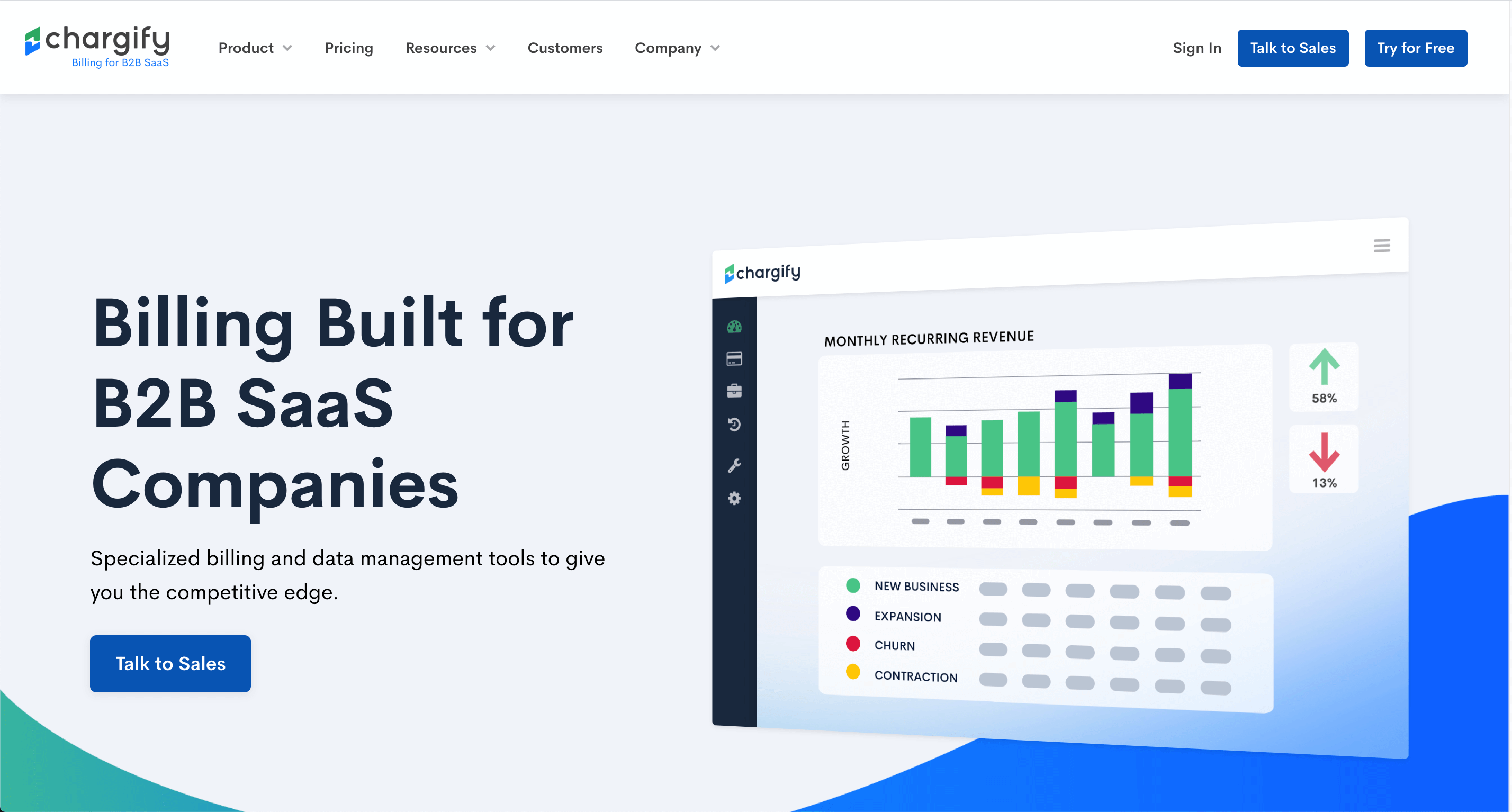
Chargify is a subscription management platform specifically for B2B SaaS companies. Unlike some of the other subscription billing services on our list, it is one of the few that targets a very specific type of recurring revenue business.
Chargify doesn’t offer a payment gateway or merchant account, so you’ll need to use it in addition to another service.
Chargify pros:
- Manages the complete customer lifecycle
- Works well if you offer multiple products
- Good for companies with complex billing plans
Chargify cons:
- Pricey for smaller SaaS companies
- Lack of customization for invoices
Chargify pricing
Chargify costs $149 per month for up to $10K in MRR, plus 1.5% of any overages.
Who is Chargify best for?
Chargify is a good fit for B2B SaaS companies with complex billing needs.
7. Authorize.net
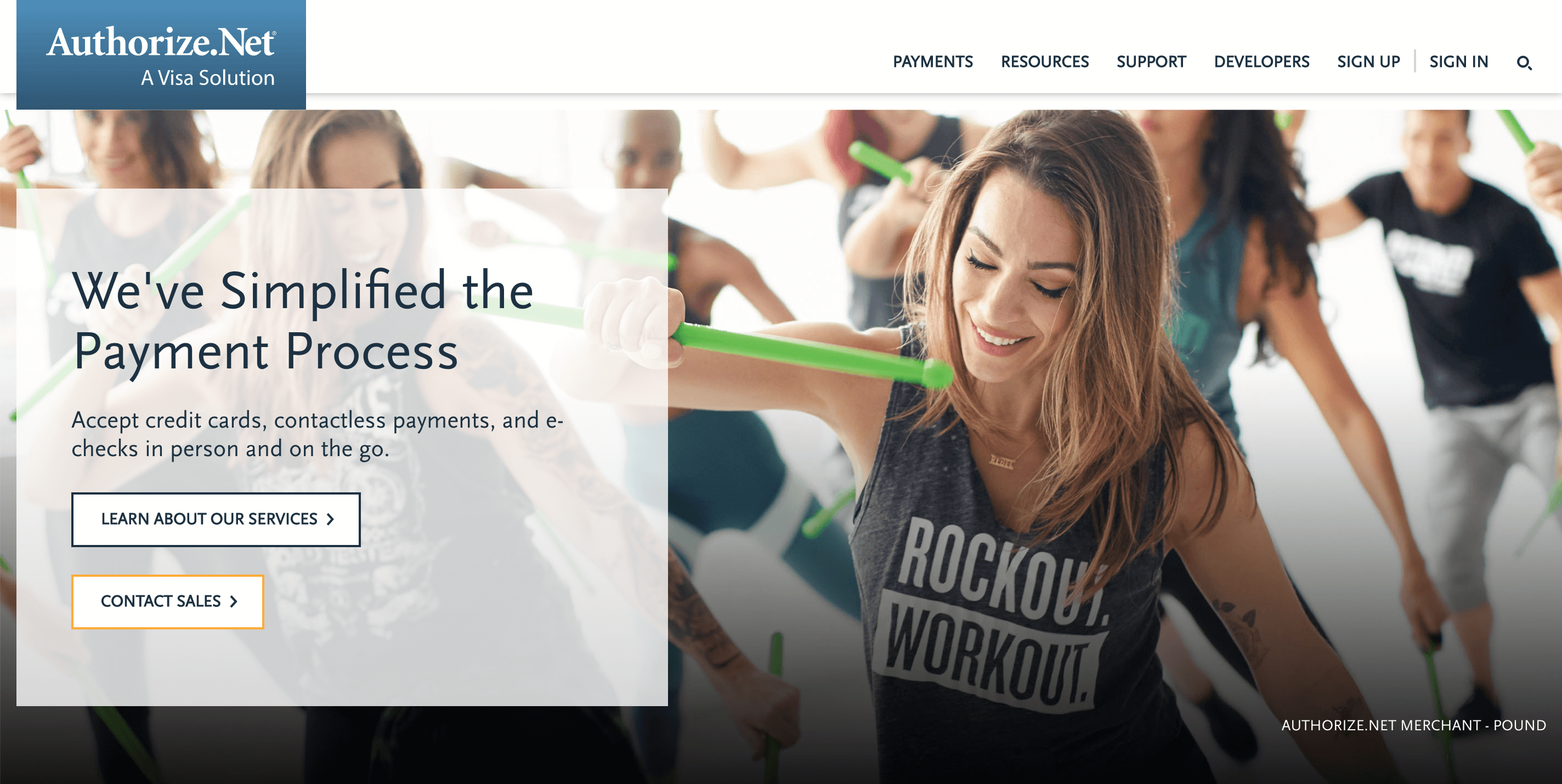
Authorize.net is a payment gateway offered by Visa. While it doesn’t have a built-in merchant account, they have a list of merchant account partners you can choose from.
While SaaS businesses aren’t their target customer, Authorize.net can be an interesting solution for certain edge cases. For instance, if you already have a merchant account and you’re using something like Recurly to manage your subscriptions.
However, for the price, a lot of SaaS companies will be better off with some of the other options on the list.
Authorize.net pros:
- Faster payment processing time (get your funds in as little as 24 hours)
- Strong anti-fraud features
Authorize.net cons:
- You’ll need other products on top of this to have a complete SaaS billing system
- It’s very basic in terms of functionality and features
Authorize.net pricing
Authorize.net costs $25 per month and charges 2.9% + $0.30 per transaction for both a payment gateway and merchant account.
Alternatively, if you just want to use the payment gateway, it costs $25 per month a fee of $0.10 per transaction, and a daily batch fee of $0.10.
Who is authorize.net best for?
Authorize.net is an option for SaaS companies that want to use their own merchant account or internal systems and just need a payment gateway.
Which SaaS billing system is right for you?
Accepting payments and managing recurring subscriptions is important for any SaaS business (otherwise, you won’t get paid), so it’s worth spending a little time weighing out your options.
For most companies, Stripe and Braintree will cover most of what you need. But options like Recurly and Chargebee will give you some additional features SaaS businesses need.
At Baremetrics, we use a combination of Stripe and our own product for analytics. If you’re interested in doing the same, you can sign up for a free trial of Baremetrics here and connect with your billing provider in one click!
FAQ's
-
How does SaaS billing work and what are the common pricing models used?
SaaS billing involves charging customers for the use of software as a service. Common pricing models include monthly or annual subscription-based plans, usage-based plans, tiered pricing, and freemium. -
What are the key factors to consider when choosing a SaaS billing solution for my business?
Key factors to consider when choosing a SaaS billing solution include:
scalability to handle your customer base
flexibility to accommodate pricing models
integration capabilities with existing systems
security and compliance features
customizable invoicing and reporting
reliable customer support
transparent pricing structures -
What are the steps involved in implementing the SaaS billing process?
The steps involved in implementing the SaaS billing process include
defining your pricing strategy
selecting a suitable billing solution
integrating the billing system with your application
setting up the product catalog and pricing plans
configuring subscription management and billing rules
implementing payment gateways
testing the billing process
providing a seamless customer experience
Typically, SaaS businesses also utilize a subscription analytics tool, which sits on top of the SaaS billing system. -
Who is responsible for setting up and managing the SaaS billing process?
The SaaS billing process typically involves multiple stakeholders such as business owners or product managers who define the pricing strategy, the development team responsible for integrating the billing system, the finance or accounting team that handles invoicing and revenue recognition, the customer support team that assists customers with billing inquiries, and the customers themselves who interact with the billing system to make payments or manage their subscriptions.
An important consideration in SaaS billing is a subscription analytics tool, which sits on top of the SaaS billing system. -
Are all SaaS billing solutions also payment gateways?
No, not all SaaS billing solutions function as payment gateways. While some billing solutions offer built-in payment gateway capabilities, allowing customers to make payments directly through the system, others integrate with external payment gateways such as Stripe, PayPal, or Braintree.




